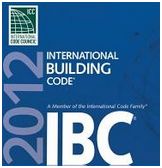Design Wind Speed Changes with Building Code Editions
Every three years a new version of the International Building Code (IBC) is printed, which brings with it the latest and greatest information for building design as approved by Code Officials. State and local permit issuing jurisdictions then can either adopt or amend the Code as they best see fit.
Even though the Code is updated on a three year cycle, some jurisdictions opt to continue to utilize earlier versions of the Code.
Provisions for design loads are set forth in Chapter 16 of the IBC.
There are significant changes to the design wind load requirements for fenestration between the 2009 IBC and the 2012 editions of the same code. These are due to significant changes to the wind load provision of ASCE (American Society® of Civil Engineers) 7 between the 2005 and 2010 edition.
The design wind load provisions of the 2005 and earlier editions of ASCE 7 were based upon allowable stress design of building components. The intent of this method was to provide loads to which the building components had a fairly high likelihood of being exposed during the service life of the building. The building components were then designed to remain serviceable (i.e. not require replacement) when subjected to this load.
The 2010 edition of ASCE 7 provides design wind load provisions which are based upon strength design of building components. This method provides loads which have a lower likelihood of occurring during the service life of the building. The building components are then designed not to fail (rupture) when subjected to this load.
 This change in methodology results in higher design wind speeds and pressures. At first glance, this might give the appearance of requiring higher DP (Design Pressure) ratings. In actuality, the 2012 IBC contains provisions to multiply this new, higher load by a factor of 0.6 for the purpose of conversion to the more traditional method of determining the design wind pressure based upon allowable stress design. It is very important the builder, code official, manufacturer and anyone else involved in choosing or approving the structural building design for a particular application understand the higher design wind pressure provided by the 2012 IBC must be multiplied by this 0.6 conversion factor.
This change in methodology results in higher design wind speeds and pressures. At first glance, this might give the appearance of requiring higher DP (Design Pressure) ratings. In actuality, the 2012 IBC contains provisions to multiply this new, higher load by a factor of 0.6 for the purpose of conversion to the more traditional method of determining the design wind pressure based upon allowable stress design. It is very important the builder, code official, manufacturer and anyone else involved in choosing or approving the structural building design for a particular application understand the higher design wind pressure provided by the 2012 IBC must be multiplied by this 0.6 conversion factor.
In most, but not all, cases this conversion results in required design pressure ratings which are roughly comparable to the more traditionally determined values.
ASCE7-10 also provides three different design wind speed maps. The different maps are based upon the assigned Risk Category of the building being designed.
- There is one map for buildings whose collapse would present a low risk to human life, such as barns and storage facilities.
- There is a second map for buildings whose collapse is considered to be a moderate hazard to human life. Most buildings fall within this category.
- There is a third map for buildings whose collapse is considered a high threat to human life, and for those which are considered essential facilities. The former includes assembly or education buildings designed to house groups of 250 or more people, some medical care facilities and any other buildings designed to house 5,000 people or more. Essential facilities include occupancies such as hospitals and police and fire stations, which are essential during emergency response situations.
The new maps result in higher design wind loads for buildings of moderate hazard to human life than for those of lower hazard. The highest design wind loads are given by the third map for buildings of high hazard to human life and essential facilities. Previous editions of ASCE 7 and the IBC also required these types of buildings to be designed to higher design loads, but the actual increase was applied in a different manner.
Considering a new post frame (pole) building? If you are looking at a building which is NOT designed by a registered design professional (RDP – engineer or architect) then there is an excellent chance the person or persons involved in the design do not understand the changes brought about by the newer editions of the Code and you could end up with an under designed building.
Under design can result in catastrophic failure – or even death. Don’t take the risk, demand an engineered building.
Your life or the lives of your loved ones could be at stake.






